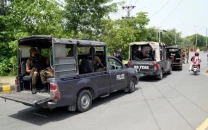Incompetence institutionalised
The Mehran raid once again raised question of the ‘enemy within’ — brainwashed servicemen recruited by...

Incompetence institutionalised
In order to minimise these limitations of the radars, the air defence command had raised in the 1960s what were known as mobile observer units (MOUs). Deployed at prominent points along the border, the MOUs were required to report, in real time, sightings of intrusions, the number and type of aircraft, their direction of flight and the altitude and speed at which they are flying. If the intrusions were not picked up by the radars, immediate action was taken on the observers’ reports by scrambling fighters, who were then assisted by them to the extent possible. Had these been in place, the Black Hawks would surely have been sighted and intercepted. But since this did not happen, the MOUs, presumably, no longer exist.
The US raid has made the air force and ISI appear in bad light. The ISI erred by surrendering the initiative to the CIA when they passed on to them the leads they got from time to time. The fact that the CIA was not sharing with them the progress made on these leads, presumably because of the trust deficit, should have alerted them. Had they carried out a parallel investigation, they just might have got to the house near Kakul earlier than the CIA.
Since the failure of the air force and ISI is incomprehensible, the question that is agitating the minds of Pakistanis is: Is there more in this sordid affair than meets the eye?
Twenty days later, it took a handful of terrorists one hour to inflict further humiliation on Pakistan. But the man at whom the buck stops tells the world, dressed in combat fatigues, that there was no security lapse and that the terrorists were well-trained.
The vulnerable area (VA) in question has two vulnerable points (VPs) — PNS Mehran and PAF Faisal. A simple methodology for developing a tactical plan for the defence of VAs and VPs is to first establish the threat perceived, then consider all the possibilities open to the enemy. From this emerges the requirement of resources to guard against all the possibilities hypothesised. The plan is then presented to the planners’ next superior officer (NSO), who keeps his NSO, the chief, in the loop. Next, the forces that will execute the joint plan are subjected to intensive training by the VA/VP commander. Last, but not least, the efficacy of the plan is tested by inviting special forces to act as the enemy.
Surprise is the main weapon of guerrillas and commandos. They employ stealth, or deception, or both, to achieve it. In the Mehran raid, stealth was employed; in the GHQ raid; deception. But when the element of surprise is compromised, the mission almost always fails.
On that fateful night, the top minds of two services were outwitted by the terrorists and their masterminds. The blame can thus be clearly apportioned.
The Mehran raid has once again raised the question of the ‘enemy within’ — servicemen brainwashed and recruited by terrorists. Apparently, very little seems to have been done to eradicate this menace, even after it was established that they had collaborated in the attacks on Musharraf, the Tarbela SSG mess and GHQ. The presence of the ‘enemy within’ adds a dangerous dimension to national security as it makes the tasks of external intelligence services that much easier. Eliminating the fifth columnists, therefore, is one of the main challenges facing the service chiefs, their counter-intelligence and the ISI.
Their other main challenge is securing their VAs and VPs against future attacks. Only when this has been assured should they focus their minds on evolving counter-terrorism policies and strategies — create strong foundations, then build on them, else the whole edifice will crumble.
Like the crises of 1965, 1971 and 1999 (Kargil), the crises of May 2011 were also the creation of a handful of men who failed to come up to the expectations of the people. Since incompetence pervaded all fields of human activity long ago, the international community is right in thinking that, like corruption, incompetence has also become institutionalised in Pakistan.
Published in The Express Tribune, June 14th, 2011.

















COMMENTS
Comments are moderated and generally will be posted if they are on-topic and not abusive.
For more information, please see our Comments FAQ